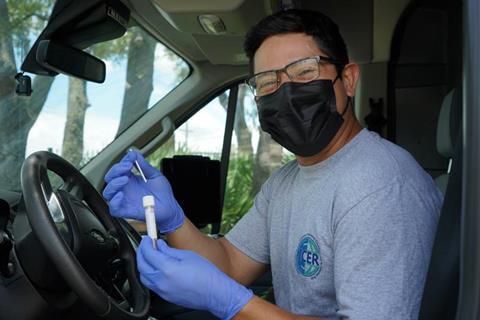University of South Florida students are leading infection control training for fire and emergency medical services personnel as part of a groundbreaking initiative supported by a multi-million-dollar cooperative agreement with the Centers for Disease Control and Prevention.

This fall, student research and project assistants will begin swabbing first responder vehicles, ambulances, fire trucks and equipment to identify pathogen exposure risks and enhance training.
READ MORE: New test for sepsis could save lives in emergency departments
“By working on this aspect of the project, I aim to not only improve the safety and preparedness of first responders, but also to empower them with the necessary tools and information to combat infectious diseases effectively,” said Logan Sharp, a USF student working towards his master’s of public health with concentrations in global communicable disease and epidemiology. “This hands-on experience in enhancing training regimes will not only benefit the current response capabilities, but also contribute to building a safer and better prepared frontline workforce in the long run.”
First responders
The findings from the swabbing studies will be used to create educational materials and resources specifically for first responders. Unlike existing materials, which are often adapted for EMS without direct input from fire and EMS personnel, these resources will be created based on their experiences and tailored to their unique needs.
“Emergency responders often perceive greater risk as they are running into a fire, for example, than from medical calls, such as going to a nursing home. During these interactions with patients, crews can come into contact with pathogens, such as MRSA,” said Christine McGuire-Wolfe, an assistant professor in the College of Public Health. “This project aims to shift that perception, emphasizing the importance of infection control in all scenarios and convincing both leadership and frontline responders how critical it is.”
As a certified firefighter herself, McGuire-Wolfe worked the frontlines for more than 20 years, experiencing firsthand the critical need for new training materials. It wasn’t until 2021, while sitting in a U.S. Fire Academy meeting, that she found the inspiration to lead the effort to create the resources herself as she listened to attendees highlight gaps in their training for basic personal protective equipment, infection prevention and decontamination procedures.
Gaps in training
“During the session’s lunch break, I searched for federal grants and this funding proposal was listed,” McGuire-Wolfe said. “I applied and received notice of funding not long after.”
McGuire-Wolfe and her project team began conducting an extensive needs assessment to ensure the training materials would be relevant and effective for EMS and fire personnel. By December 2023, the CDC extended an additional $2.3 million to broaden the project’s scope, underscoring its importance and impact.
One of the largest outcomes of the project is the establishment of the Infection Control for Emergency Responders (ICER) Collaborative and Training Hub that will include digital resources and infection control education for emergency responders across the nation.
Building trust
“A critical aspect of this initiative is building trust among field personnel,” McGuire-Wolfe said. “By establishing ICER as a reliable source of infection control information, the project aims to bridge this gap.”
The ultimate goal of ICER is to foster a culture of workplace safety that includes infection prevention and control as a critical component, emphasizing the relevance and importance of these practices and creating a more prepared fire and EMS workforce in the event of future pandemics.
This project is supported by the Centers for Disease Control and Prevention of the U.S. Department of Health and Human Services (HHS) as financial assistance with 100 percent funded by CDC/HHS.







No comments yet